

44 Prompts Merging Reflective Thinking With Bloom's Taxonomy. 44 Prompts Merging Reflective Thinking With Bloom’s Taxonomy by Peter Pappas It’s been four years since I first published my “Taxonomy of Reflection.”
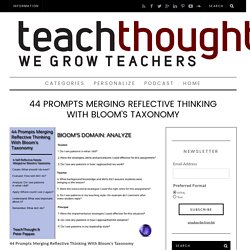
My interest in reflective thinking is rooted in a simple but powerful statement by Donald Finkel who wrote that teaching should be thought of as “providing experience, provoking reflection.” (Teaching with Your Mouth Shut) Most school mission statements include a reference to “fostering life-long learners.” Unfortunately, self-reflection is rarely taught in school. I developed my Taxonomy of Reflection in an effort to provide a schema of prompts that could be used by students, teachers and administrators to hone their reflective skills. Seen through Bloom, that’s the equivalent of “Remembering: Retrieving, recognizing, and recalling relevant knowledge from short- or long-term memory.”
Below are 44 sample of higher order reflective prompts. 1. AnswerGarden - Plant a Question, Grow Answers! Generate a live word cloud with your audience. 7 Important Tips for Providing Effective Feedback to Your Students. March 20, 2014 Feedback is an essential element in the teaching/learning process.
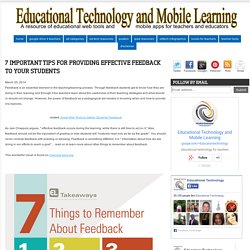
Through feedback students get to know how they are doing in their learning and through it too teachers learn about the usefulness of their teaching strategies and what should or should not change. However, the power of feedback as a pedagogical aid resides in knowing when and how to provide it to learners. As Jam Chappuis argues, " effective feedback occurs during the learning, while there is still time to act on it. " Also, feedback should not be the equivalent of grading or else students will "routinely read only as far as the grade". You should never confuse feedback with praising or advising. This wonderful visual is found on inservice.ascd.org. 20 Ways To Provide Effective Feedback For Learning - 20 Ways To Provide Effective Feedback For Learning by Laura Reynolds While assessment gets all the press, it is feedback for learning that can transform a student’s learning.
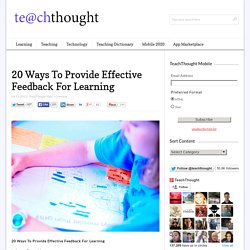
When feedback is predominately negative, studies have shown that it can discourage student effort and achievement (Hattie & Timperley, 2007, Dinham). Like my experience, the only thing I knew is that I hated public speaking and I would do anything possible to get out of it. As a teacher, most of the time it is easy to give encouraging, positive feedback. 5 Heutagogical Tips to Empower Lifelong Learners Online. 5 Heutagogical Tips to Empower Lifelong Learners Online Prior to joining the marketing team at SchoolKeep, I worked as an educational program manager for an experiential learning company.

As the company grew, I was forced to take on new, intimidating marketing tasks. I realized I had quite a bit to learn. Instead of going back to school for a marketing degree, however, I found HubSpot’s blog, which led to their Academy, and then of course to Inbound.org. Here, I found a place to continuously learn from and contribute to a huge digital marketing community.
During my transition to marketing, I became a heutagogic learner in just under 3 months, meaning I was markedly more self-determined, motivated and highly autonomous, without ever setting foot in a classroom. In a world where information is instantly available to us, the educator is no longer the sole proprietor of subject matter expertise. How To Give Feedback to Students. Types of Student Teaching. Traditional Student Teaching Traditional student teaching placements are made by the subject area program coordinator with cooperating teachers in area schools with which CSULB has a current affiliation agreement.
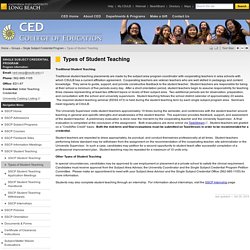
Cooperating teachers are veteran teachers who are well skilled in pedagogy and content knowledge. They serve to guide, support, and provide constructive feedback to the student teacher. Student teachers are responsible for being at their school a minimum of five periods every day. After a short orientation period, student teachers begin to assume responsibility for teaching three classes representing at least two different topics or levels of their subject area. The University Supervisor visits student teachers approximately 10 times during the semester, and conferences with the student teacher around teaching in general and specific strengths and weaknesses of the student teacher.
Turnitin Document Viewer. Voice Tools. Voice tools allow teachers and students to make and listen to voice recordings in Moodle.
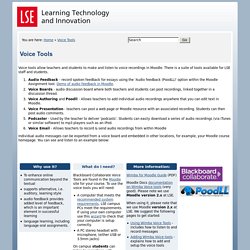
There is a suite of tools available for LSE staff and students. Audio Feedback - record spoken feedback for essays using the 'Audio feedback (PoodLL)' option within the Moodle Assignment tool. Demo of audio feedback in Moodle. Voice Boards - audio discussion board where both teachers and students can post recordings, linked together in a discussion thread. Voice Authoring and Poodll - Allows teachers to add individual audio recordings anywhere that you can edit text in Moodle. Why use it? To enhance online communication beyond the textual supports alternative, i.e. auditory, learning style audio feedback provides added level of feedback, which is an important element in successful learning language learning, including language oral assignments.
What do I need? ‘Speaking to Students’ with Audio Feedback in Online Courses. In this post I’ll share how to give meaningful and constructive feedback to students on assignments, presentations, and other works by using voice recorded files. Research suggests that students want specific and detailed feedback from their instructors (Balaji & Chakrabarti, 2010 ). Who wouldn’t? The Best Web-based Audio Recording and Editing Tools for Teachers and Students. April 6, 2014 In today's post I am sharing with you a bunch of useful web tools that you can use with your students to record and share audio clips.
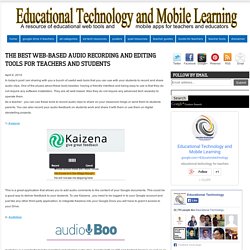
One of the pluses about these tools besides having a friendly interface and being easy to use is that they do not require any software installation. They are all web based. Also they do not require any advanced tech wizardry to operate them. Best Methods and Tools for Online Educators to Give Students Helpful and Meaningful Feedback. In last week’s post Tools-of-the-Trade to Make your Online Teaching Even Better I reviewed various tools that help online educators make a connection with students by using media other than text to deliver guidance and instructions to students in online classes.
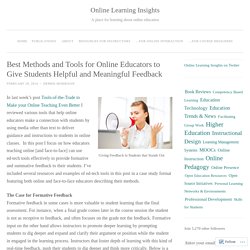
In this post I focus on how educators teaching online [and face-to-face] can use ed-tech tools effectively to provide formative and summative feedback to their students. I’ve included several resources and examples of ed-tech tools in this post in a case study format featuring both online and face-to-face educators describing their methods.
The Case for Formative Feedback Formative feedback in some cases is more valuable to student learning than the final assessment. For instance, when a final grade comes later in the course session the student is not as receptive to feedback, and often focuses on the grade not the feedback. Case Study #2 Feedback [formative and summative] via Screen Casts. Other Resources: Like this: The wonderful world of feedback and correcting: focusing on the writing skill by Joanna Malefaki. Our next guest blogger has been a speaker at two BELTA events this year – the BELTA Day in March and the TOBELTA online conference in August.
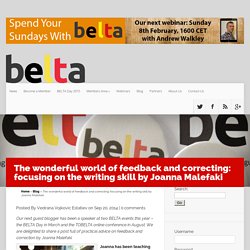
We are delighted to share a post full of practical advice on feedback and correction by Joanna Malefaki. Joanna Malefaki Joanna has been teaching for about 16 years mostly in Greece, the UK and now online. 5 Free Tools to Collect Student Feedback. There are several free web tools that teachers can use to gather feedback from their students both formally and informally.

You can also use these tools to poll your students about a learning event, assess their level of comprehension, or simply to get to know their opinions about a certain topic. Educational Technology and Mobile Learning has already posted a list of such tools last year but today we are updating this list deleting the ones that no longer work and including new ones . Check out the list below and as usual share with us your suggestions or additions. Peer Editing - Ladder of Feedback. » A Feedback Tool for Instructors: PassNote Purdue University. PassNote is a student feedback tool designed to assist instructors in composing research-based messages that motivate students to academic action. Our goal in creating the tool was to address concerns several instructors brought to our attention related to the difficult task they had in composing effective feedback messages related to course performance for students based on best practices.1 The research we found was extremely specific in helping us come up with criteria that were most likely to motivate students.
Some words worked better than others and writing shorter messages increased the chances students would read them.2 Comments that did not provide specific resources were less effective.3 As we investigated the research, a pattern for success became more clear. We followed this pattern in the construction of our library. Another concern we have looked to address was to try to provide a library that would inspire individual responses as much as possible. . [2] Patricia E. PassNote. Why it Works Students receiving constructive feedback from faculty report gains in problem solving and communication skills. Feedback perceived as encouraging and aiding in student development tends to be more effective.
Students note that late feedback (e.g., after its usefulness has expired) is not at all helpful nor effective. Framework_Paper.pdf. Imperial College London. Oral feedback During teaching sessions tutors may give you oral feedback. On some modules you will have lots of contact hours and opportunities for discussion. Other modules may offer fewer teaching sessions and you will be expected to ask tutors if you feel you require additional feedback. Creating a Thoughtful Classroom: Using Learning Logs for Reflection and Formative Assessment during Units of Inquiry. Are you looking for a no-fuss way to assess students along the way during a unit of study or inquiry? Learning Logs are a fantastic way to do this! What are learning logs? Learning logs are a journal of a student's learning experiences.
They give children an opportunity to stop and think about what and how they are learning and feeling during a unit. It helps students become more aware of the process of learning as well as the deepen understandings of and personal connections to the topic of study. Learning logs can be very open [blank pages] or guided [specifically designed] pages; it's really up to you and what your goals are. Effective feedback. 3 Student Self Assessment. What is a Learning Log? (with picture) Peer and Self Assessment. Assessing Learning Peer Assessment One of the ways in which students internalize the characteristics of quality work is by evaluating the work of their peers. Learning Logs to inspire and guide student growth. August 17, 2014 by Nick Mitchell. New Zealand Physical Educator - Raising student achievement through learning logs and formative feedback (Humanities & Social Sciences Collection) - Informit.
Howard Rheingold - Social Media and Peer Learning: From Mediated Pedagogy to Peeragogy. What Is Peer Mentoring? What Is Peer Mentoring? Peer mentoring programs match older youth with young students in one-on-one relationships to provide guidance for the children. Through this special relationship, peer mentors provide advice and support and serve as role models for younger people who need help. Feedback Dialogues.
Focus on Feedback: Examining Alternative Methods for Efficiency and Effectiveness « IH Journal. Gathering Feedback from Students. Short feedback questionnaires for evaluating teaching : CATL : The University of Western Australia. Before you begin teaching your classes, you might consider asking your students to list three to five attributes a good teacher has. This approach is useful to understand your audience and is beneficial when used early in the unit. Alternative Feedback Techniques. It is important that you yourself ask for feedback from your fellow students, teachers, and supervisors.
The more feedback you get, the more you will learn. Alternatives To 'Correct' and 'Incorrect' Sharebar Imagine a trainer at the front of the room responding to a participant’s comment by saying nothing more than “You’re right!” Or “Incorrect.” Imagine this happening over and over again. Even though it seems futile, this is one of the most common types of feedback we use in eLearning courses to respond to user actions and answers. In fact, many authoring tools come with these vacuous statements as their default response. Focus on Feedback: Examining Alternative Methods for Efficiency and Effectiveness « IH Journal. Learning Logs to inspire and guide student growth.
Technology Tools for Learning Logs. Creating a Thoughtful Classroom: Using Learning Logs for Reflection and Formative Assessment during Units of Inquiry. Metacognition and Learning. Teaching Metacognition. The Science of Metacognition. Frontiers in Human Neuroscience. Meta-cognition and self-regulation. Lucid dreams and metacognition: Awareness of thinking - awareness of dreaming. 50 Questions To Promote Metacognition In Students. Toward Peeragogy. What is Peeragogy? Peeragogy: Self Organized Peer Learning in Networks. Peeragogy Handbook V1.0.